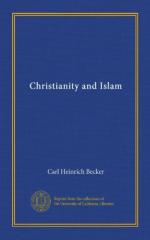More important, however, was the development of the official service, the arrangement of the day and the hour of obligatory attendance and the introduction of preaching: under Muhammed and his early followers, and until late in the Omajjad period, preaching was confined to addresses, given as occasion demanded, but by degrees it became part of the regular ritual. With it was afterwards connected the intercession for the Caliphs, which became a highly significant part of the service, as symbolising their sovereignty. It seems to me very probable that this practice was an adoption, at any rate in theory, of the Christian custom of praying for the emperor. The pulpit was then introduced under Christian influence, which thus completely transformed the chair (mimbar) of the ancient Arab judges and rulers and made it a piece of church furniture; the Christian cancelli or choir screens were adopted and the mosque was thus developed. Before the age of mosques, a lance had been planted in the ground and prayer offered behind it: so in the mosque a prayer niche was made, a survival of the pre-existing custom. There are many obscure points in the development of the worship, but one fact may be asserted with confidence: the developments of ritual were derived from pre-existing practices, which were for the most part Christian.
But the religious energy of Islam was not exclusively devoted to the development and practice of the doctrine of duties; at the same time this ethical department, in spite of its dependency upon Christian and Jewish ideas, remains its most original achievement: we have pursued the subject at some length, because its importance is often overlooked in the course of attempts to estimate the connection between Christianity and Islam. On the other hand, affinities in the regions of mysticism and dogma have long been matter of common knowledge and a brief sketch of them will therefore suffice. If not essential to our purpose within the limits of this book, they are none the less necessary to complete our treatment of the subject.
By mysticism we understand the expression of religious emotion, as contrasted with efforts to attain righteousness by full obedience to the ethical doctrine of duties, and also in contrast to the hair-splitting of dogmatic speculation: mysticism strove to reach immediate emotional unity with the Godhead. No trace of any such tendency was to be found in the Qoran: it entered Islam as a complete novelty, and the affinities which enabled it to gain a footing have been difficult to trace.
Muhammedan mysticism is certainly not exclusively Christian: its origins, like those of Christian mysticism, are to be found in the pantheistic writings of the Neoplatonist school of Dionysius the Areopagite: but Islam apparently derived its mysticism from Christian sources. In it originated the idea, with all its capacity for development, of the mystical love of God: to this was added the theory and practice




